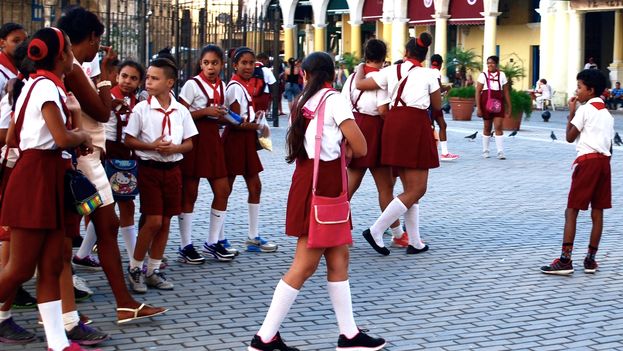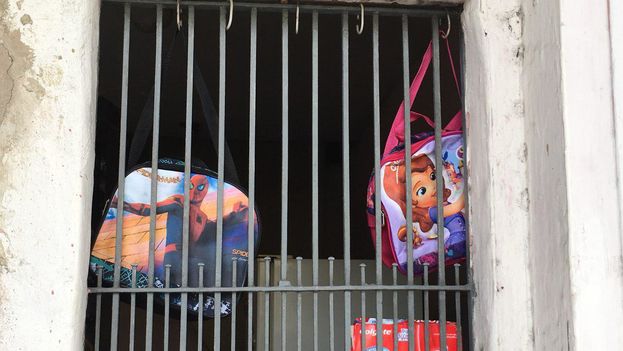
![]() 14ymedio, Luz Escobar, Havana, 30 August 2017 — These are frantic days. The uniform has to be ready, and a supply of pencils, erasers and pencil sharpeners collected. The school year begins on Monday, and each year the cost of equipping a student for the classroom increases. Cuban families spend nearly an entire month’s average salary on these preparations, according to interviews conducted with several parents by 14ymedio.
14ymedio, Luz Escobar, Havana, 30 August 2017 — These are frantic days. The uniform has to be ready, and a supply of pencils, erasers and pencil sharpeners collected. The school year begins on Monday, and each year the cost of equipping a student for the classroom increases. Cuban families spend nearly an entire month’s average salary on these preparations, according to interviews conducted with several parents by 14ymedio.
Yampier Lopéz and his wife, parents of two children, keep a detailed account of the money invested to prepare their children for classes. Shoes and backpacks are the most expensive, but the list continues to grow with two water bottles, a compass for the older brother who is beginning the study of geometry, and two lunch boxes.
With a total of 1,750,000 students enrolled at all levels of education, the new school year unleashes a race against the clock in state stores and in the black market. Families are guided by the simple motto: buy the most durable products at the lowest possible price.
For each child, Lopéz and his wife have so far invested 740 Cuban pesos (CUP), the equivalent of an average monthly salary according to the latest data provided by the National Bureau of Statistics and Information (ONEI), but they predict that the figure will exceed 1,000 CUP by the time they acquire some missing items.
Families are guided by the simple motto: buy the most durable products at the lowest possible price.
“We have to try to find most of the things that are used throughout the school year and now is the time to buy,” says the father. “You almost always think of the most visible, but you also have to look for socks, shorts for PE and notebooks.”
Lopez is a designer, while his wife works as a secretary in a branch of the Ministry of Transportation. Both remember the 1980s when they entered primary school and “in school they gave us almost everything.” But the collapse of socialism in Eastern Europe and the economic crisis have reduced those subsidies to the minimum.
The Government has significantly reduced its investment in the education sector, from 14.1% of GDP in 2005 to 9% in 2017
In recent years the Government has significantly reduced its investment in the education sector, from 14.1% of GDP in 2005 to 9% in 2017. The cut affects the physics and chemistry labs, audiovisual equipment, and the teaching materials given to each student.
For the 2017-2018 academic year, the Minister of Education, Ena Elsa Velázquez Cobiella, told the official press that “all textbooks and workbooks are guaranteed,” although she acknowledged that there are problems with “paper, because there is a delay in the arrival of that resource from abroad.”

School uniforms cost less than 10 Cuban pesos (about 40¢ US) at subsidized prices, but the quantity delivered is limited and there is little variety in sizes. In Miami, with a large Cuban community, several stores offer the uniform pieces — blouses, shirts, skirts, shorts and trousers — the students are required to wear in primary and secondary education on the island. These days the emigrants receive frequent orders for these products from their families in Cuba.
“To guarantee a clean uniform every day, I have to buy at least three blouses and two skirts, says Damy, a 34-year-old Santiagan whose daughter is starting the second grade in September. Resellers offer each piece at a price ranging from 50 to 75 CUP, more than five times the cost in the state stores, which offer only one uniform per child at the subsidized price.
After the uniform, shoes are one of the main concerns because in the state stores they cost between 140 and 380 CUP. To that is added the amount for the socks (25 CUP per pair) and the backpack (never less than 300 CUP) which brings the sum to the monthly salary of an engineer or a teacher.
“This is not over, the next few months my wife and I will be working almost exclusively so that our children can go to school with a clean uniform, pencils, notebooks and some cookies for a snack”
There are no official data on the expenses incurred by an average family for each child who starts school, but several economists consulted by this newspaper agree that it represents a difficult challenge given that the purchasing power of the Cuban worker has declined in recent years to only 28% of what was received in 1989.
Last July, the economist Carmelo Mesa-Lago told the conference of the Association for the Study of the Cuban Economy (ASCE) that although “free and universal access are important and redeemable points” of the Cuban education system, it is necessary “to focus resources on those provinces and people who cannot pay for their studies.”
The situation becomes tense a few days before the beginning of September. Although the uniform is mandatory, social inequalities arise in the quality of the footwear or the backpack. In the past, school officials have tried to prevent students bringing snacks or sandwiches that indicate greater purchasing power to the classroom, but they’ve lost the battle because the schools no longer are able to provide free snacks, as they did in the past.
“Before they gave the students crayons, pencils and notebooks of better quality, but now all that is up to the family,” complains Yander Lopéz. Books are distributed among students free of charge, but must be returned at the end of the course. Higher income families buy part of these “basic study materials” on the black market.
This school year, families’ pockets are emptied a little more by the costs of the school snack, the so-called “reinforcement” of the school-provided lunch by which the families improve their children’s nutrition in the semi-boarding schools, and the purchase of cleaning supplies, which parents must provide for some schools that are receiving fewer and fewer tools and supplies to clean the buildings.
“This is not over, the next few months my wife and I will be working almost exclusively so that our children can go to school with a clean uniform, pencils, notebooks and some cookies for a snack,” laments Lopéz.
